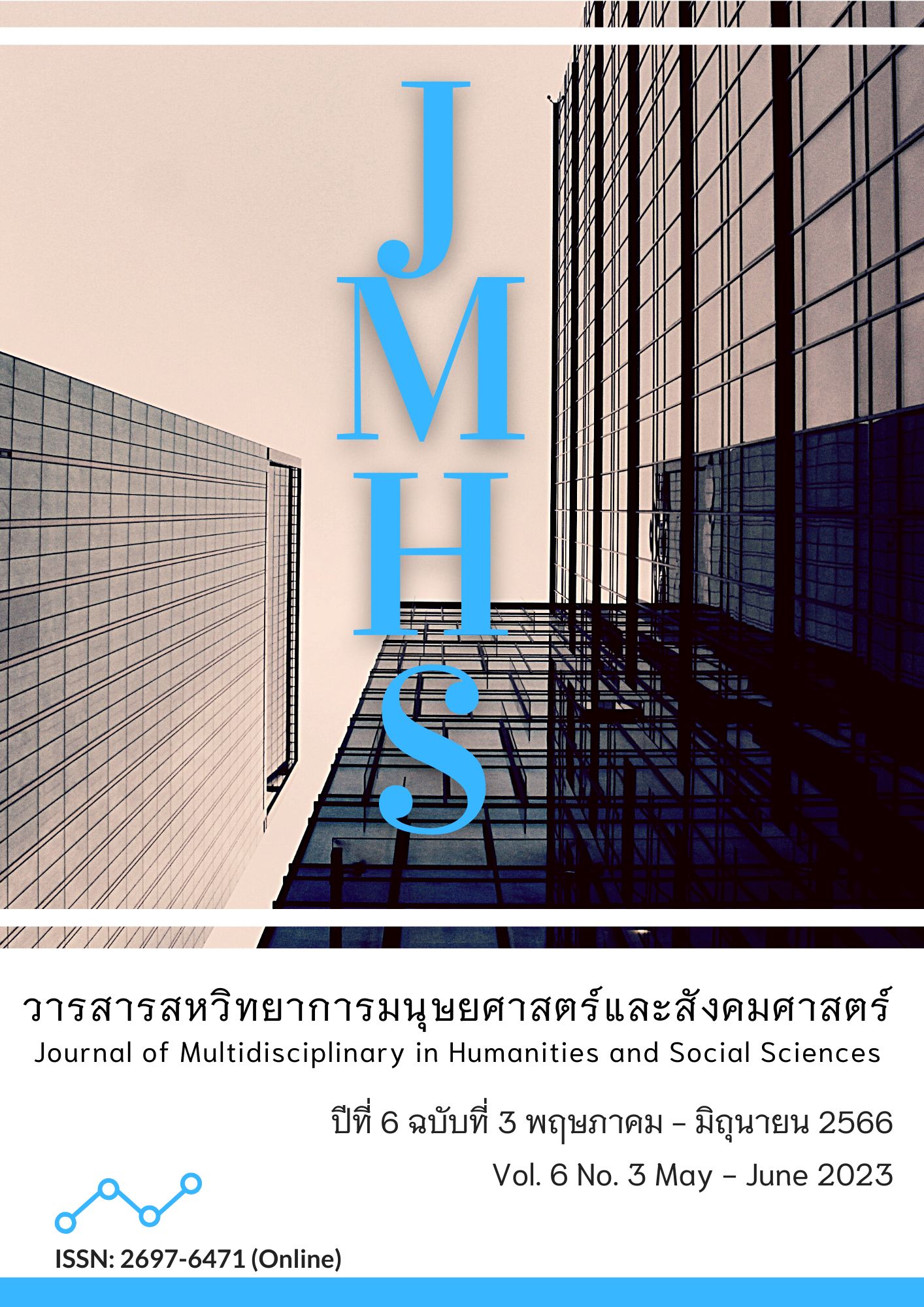Causal Factors Influencing Coffee Consumers’ Purchasing Decisions
Main Article Content
Abstract
The research article presented the causal factors influencing the purchasing decisions of coffee consumers. The objectives of this research were to 1) investigate the causal factors influencing the purchasing decision of coffee consumers and 2) examine the approach to creating factors influencing the purchasing decision of coffee consumers. The methodology used in the research was a mixed-methods study. In the quantitative approach, the questionnaires were used as a research tool. The sample group was 405 coffee consumers. They were randomly selected and quota selected. The data were analyzed using descriptive and inferential statistics. In the qualitative method, the research instrument was semi-structured interviews. The key informants were eight coffee entrepreneurs, who were selected by purposive sampling. The data were analyzed descriptively. The findings were as follows:
1) Service quality had a direct influence on consumers' purchasing decisions and brand value with statistical significance, with influence sizes of 0.18 and 0.71, respectively. Brand value directly influenced purchasing decisions, with an influence size of 0.75, while service quality indirectly influenced purchasing decisions through brand value, with an influence size of 0.54.
2) The guidelines for creating factors influencing coffee consumers’ purchasing decisions were that the entrepreneurs should emphasize staff who have good personalities and are friendly. Moreover, it suggested using well-arranged modern tools and equipment, having fast service, decorating the coffee shop’s atmosphere attractively, providing places for customers to take photos, and having good-quality products with a standard. The coffee shop’s name should be easy to memorize and provide a unique logo. The menu should be varied and unique.
The findings will be beneficial for coffee entrepreneurs in developing strategies for service quality and brand value to increase customers’ purchasing decisions.
Article Details

This work is licensed under a Creative Commons Attribution-NonCommercial-NoDerivatives 4.0 International License.
Views and opinions appearing in the Journal it is the responsibility of the author of the article, and does not constitute the view and responsibility of the editorial team.
References
ทิพเนตร สิทธิกรรม. (2565). ธุรกิจร้านกาแฟ. สืบค้นเมื่อ 25 กรกฎาคม 2565, จาก https://sites.google.com/site/thipnetsittikam/tidtx-rea/www-netrbarista
ไทยเอสเอ็มอี เซ็นเตอร์. (2560). อย่าท้อ! 5 ปัญหาสำหรับคน เปิดร้านกาแฟ ต้องเจอแน่นอน. สืบค้นเมื่อ 17 กรกฎาคม 2565, จาก http://www.thaismescenter.com/อย่าท้อ-5-ปัญหาสำหรับคน-เปิดร้านกาแฟ-ต้องเจอแน่นอน
บุญไทย แสงสุพรรณ และ กฤษดา เชียรวัฒนสุข. (2563). คุณค่าของตราสินค้าและปัจจัยส่วนประสม การตลาดบริการที่มีผลต่อการตัดสินใจซื้อซ้ำของผู้บริโภคกาแฟร้านคาเฟ่อเมซอน สาขาในห้างสรรพสินค้า จังหวัดปทุมธานี. วารสารวิชาการคณะมนุษยศาสตร์และสังคมศาสตร์ มหาวิทยาลัยราชภัฏเทพสตรี, 11(1), 47-59. สืบค้นจาก https://so01.tci-thaijo.org/index.php/truhusocjo/article/download/242590/164724/844145
ประชาชาติธุรกิจ. (2561). กาแฟไทย ก้าวสู่ตลาดโลก. สืบค้นเมื่อ 20 กรกฎาคม 2565, จาก https://www.prachachat.net/columns/news-172057
พิมพกานต์ กันปันสืบ และ พรรณนุช ชัยปินชนะ. (2565). ปัจจัยที่มีผลต่อการตัดสินใจเลือกซื้อน้ำดื่ม ผสมวิตามินบรรจุขวดของผู้บริโภค Gen Y ในเขตอำเภอเมือง จังหวัดเชียงใหม่. วารสารวิชาการสมาคมสถาบันอุดมศึกษาเอกชนแห่งประเทศไทย (สสอท.), 28(2), 105-115. สืบค้นจาก https://so06.tci-thaijo.org/index.php/apheit-ss/article/view/259397/175368
วิยะดา วรธนานันท์. (2557). กลยุทธ์การพัฒนาคุณภาพการบริการ. สืบค้นเมื่อ 21 มีนาคม 2566, จาก https://www.stou.ac.th/study/sumrit/8-60/page5-8-60.html
สาลิกาดอทซีโอ. (2562). ทุกสิ่งที่ต้องรู้ ตอบคำถาม ‘เปิดร้านกาแฟ ดีไหม?’ ธุรกิจยอดฮิตที่ยังครองใจผู้ประกอบการรุ่นใหม่. สืบค้นเมื่อ 21 กรกฎาคม 2565, จาก https://www.salika.co/2019/02/21/open-cafe-strategy/
สุมามาลย์ ปานคำ และ กรรณิการ์ ไพบูลย์. (2564). ปัจจัยเชิงสาเหตุที่มีอิทธิพลต่อพฤติกรรมความตั้งใจในการใช้บริการรับออกแบบตกแต่งภายในบ้านผ่านเพจเฟซบุ๊กของผู้บริโภคในเขตกรุงเทพมหานครและปริมณฑล. วารสารสหวิทยาการมนุษยศาสตร์และสังคมศาสตร์, 4(2), 521-535. สืบค้นจาก https://so04.tci-thaijo.org/index.php/jmhs1_s/article/view/249626
Aaker, D. A. (1991). Managing brand equity: Capitalizing on the value of a brand name. New York: The Free Press.
Aaker, D. A. (1996). Construir Marcas Poderosas/Building strong brands. New York: The Free Press.
Andreasen, A., & Kotler, P. (2003). Strategic marketing for non-profit organizations. Upper Saddle River, NJ: Prentice Hall.
Creswell, W. J., & Creswell, D. J. (2018). Research design: Qualitative, quantitative, and mixed methods approach. London: Sage.
Diamantopoulous, A., & Siguaw, A. D. (2000). Introducing LISREL: A guide for the uninitiated. London: Sage.
Faul, F., Erdfelder, E., Buchner, A., & Lang, A. (2009). Statistical power analyses using G*Power 3.1: Tests for correlation and regression analyses. Behavior Research Methods, 41(4), 1149- 1160. https://doi.org/10.3758/BRM.41.4.1149
Goutam, D., Ganguli, S., & Gopalakrishna, B.V. (2022). Technology readiness and e-service quality – impact on purchase intention and loyalty. Marketing Intelligence & Planning, 40(2), 242-255. https://doi.org/10.1108/MIP-06-2021-0196
Habib, D. M., & Sarwar, A. M. (2021). After-sales services, brand equity and purchasing intention to buy second-hand product. Rajagiri Management Journal, 15(2), 129-144. https://doi.org/10.1108/RAMJ-07-2020-0033
Hu, L., & Bentler, M. P. (1999). Cutoff criteria for fit indexes in covariance structure analysis: Conventional criteria versus new alternatives. Structural Equation Modeling, 6(1), 1-55. https://doi.org/10.1080/10705519909540118
Juga, J. Juntunen, J., & Paananen, M. (2017). Impact of value-adding services on quality, loyalty and brand equity in the brewing industry. International Journal of Quality and Service Sciences, 10(1), 61-71.https://doi.org/10.1108/IJQSS-10-2016-0071
Kolter, P., & Keller, K. L. (2012). Marketing management (12th ed). Edinburgh Gate: Pearson Education.
Liu, C., Zhang, Y., & Zhang, J. (2020). The impact of self-congruity and virtual interactivity on online celebrity brand equity and fans’ purchase intention. Journal of Product & Brand Management, 29(6), 783–801. https://doi.org/10.1108/JPBM-11-2018-2106
Zeithaml, V. A., Berry, L. L., & Parasuraman, A. V. (1996). The Behavioral Consequences of Service Quality. Journal of Marketing, 60(2), 31-46. https://doi.org/doi:10.2307/1251929


